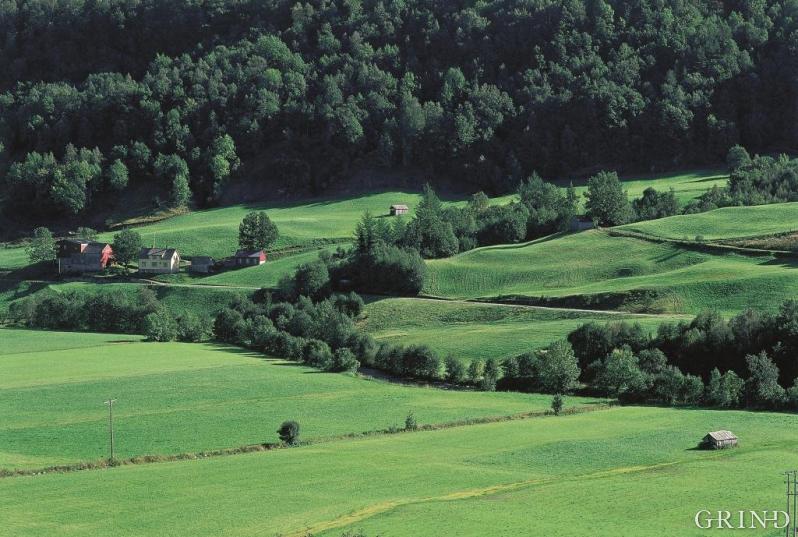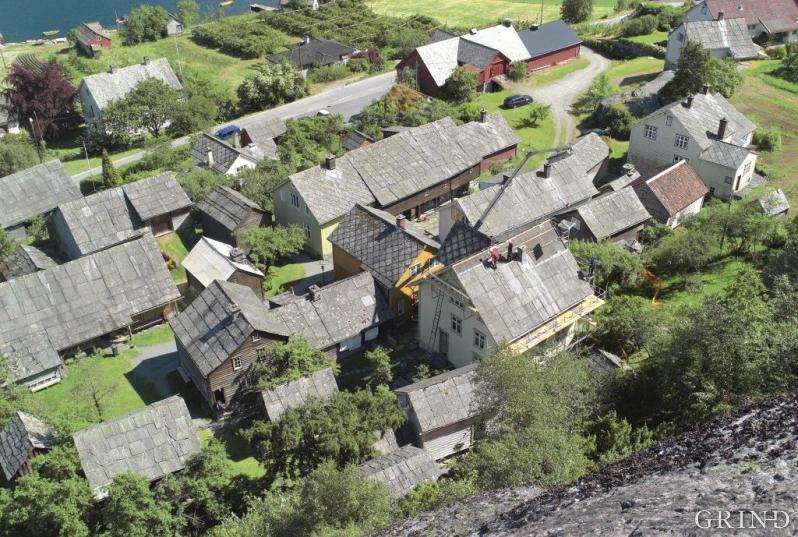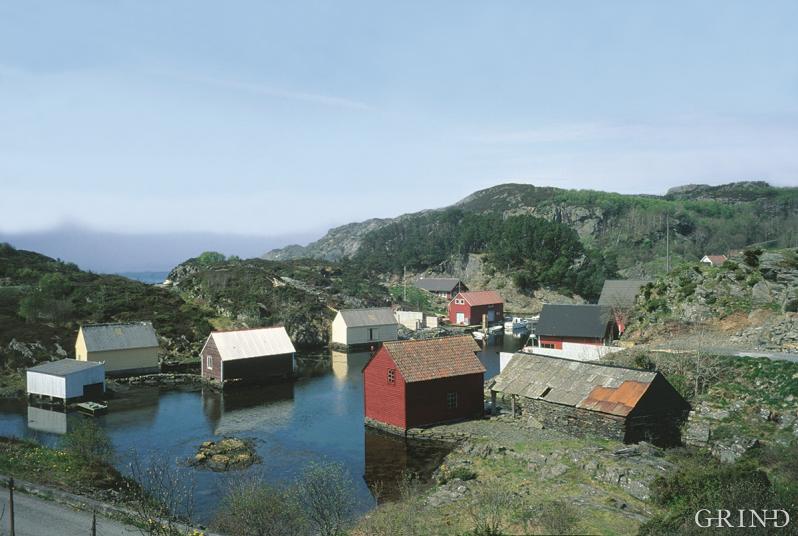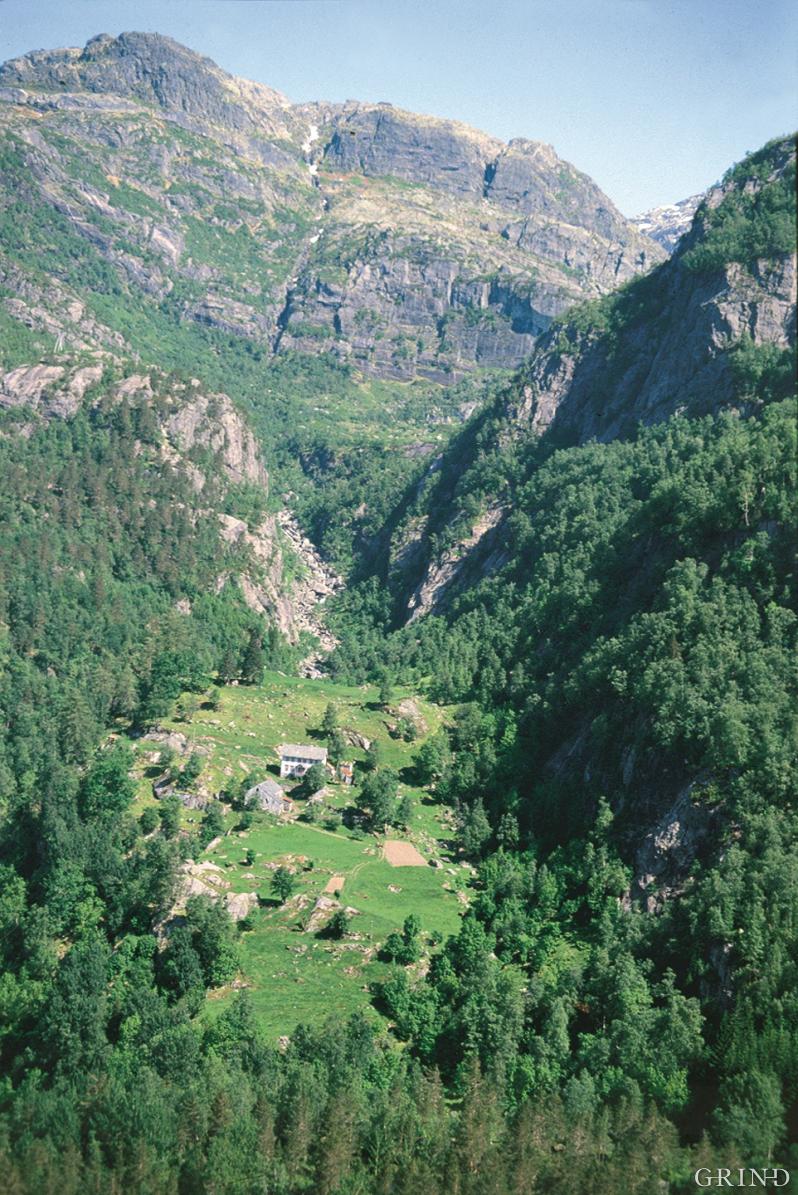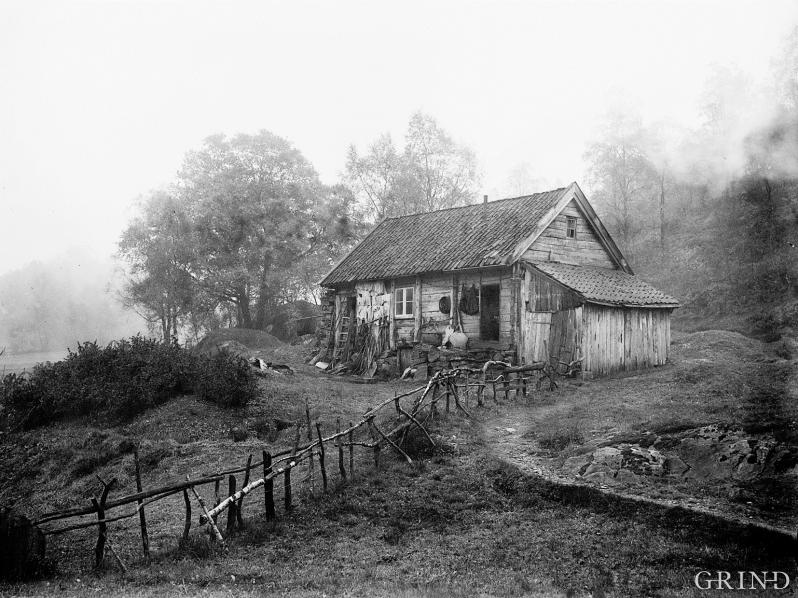Published: 19.05.2009 | Author: Ståle Dyrvik
Høyonn med høyvogn i 1927. Bedehuset i Leirvågen, Austrheim i bakgrunnen (foto: Soltvedt Scanner Studio, i privat eige).
The cultural landscape or that part of it which is still green and inviting to the eye has been shaped by the farmers’ toil down through the generations. At one time almost all of us were farmers. From the census of 1801 we can see that about 95% of the inhabitants of Søndre Bergenhus county, outside Bergen, had their most important income from the land. Thus it is the farmers’ social life and culture which are still a feature of many local societies. When people imagine a typical “Strile ” man or someone from Voss, is he not a farmer?
In search of characteristic features
As the landscape changes so too do agriculture’s natural conditions, from the fisher-farmer’s smallholding along the coast to the big forest farms in Voss or the corn districts of inner Sunnhordland. In this brief investigation we shall look at how agricultural conditions affected farming society in Hordaland county from the Middle Ages to the period of transition in the late 1800s. How do villages and rural districts distinguish themselves from one another. As it is impossible to describe all the aspects, we have to select a bunch of distinguishing marks which can be especially eloquent. We can agree on population and population growth, farm structure, the property situation and the crofting system.
The investigation is based on figures which can appear at once grey and boring. But these are the historian’s building blocks. They are solid and lead to important conclusions.
Now it is easy to convince oneself that if only we can go a few generations back we shall come upon a pattern which has been there from the beginning of time. But depopulation in the late Middle Ages and the new periods of growth in the 16th, 17th and 19th centuries show that the old faming society was not static. There is nothing to suggest that different parts of the county experienced these phases of change in the same way. Nor is it certain that it was precisely the conditions in the 19th century which “explain” a particular district or local society. A collective is, in the same way as an individual person, the product of development over time. We cannot always know in advance which phases in the course of a life have had most effect.
The middle ages and the time of desolation
How was it to be a farmer in the shadow of Bergen, the national capital in the High Middle Ages? The king, the church and the great nobles obtained most of their riches from their landed estates. The further one came from the centres of political power, the more usual it was that the farmers owned their own land.
Amongst the farmers of Hordaland in the Middle Ages there were more tenants than otherwise in most of the country. Munkeliv, Lyse Monastery and Halsnøy Monastery had great landed estates which extended to every corner of the County. In addition there were great estates of the nobility. It appears that individual ownership was greatest in Voss, but here too these farmers were also in the minority.
In the wake of the Black Death came a reduction in the population. Within individual rural districts a concentration of settlements took place towards the more central and best agricultural areas. We know less about the outcome on a district by district basis. But it does seem that inner areas like Voss and Hardanger experienced a greater reduction than the outer ones. That this should be a direct reflection of the situation within agricultural does not seem to be completely obvious. It is possible that remote areas were particularly subject to emigration.
From around 1520 tax recordings have been found which make it possible to obtain the first reasonably reliable picture of settlement and population within the county. Unfortunately this material has only been analysed so far for some few rural districts. So far we can guess that there lived between 10,000 and 15,000 people in the rural districts in Hordaland around 1500 AD.
Population growth in the 16th and 17th centuries
Up until the middle of the 17th century there was a powerful increase in the population in all parts of the county. From the 1660s we have a series of registers which makes it possible for us to read off the status at the end of this period of growth. At that time about 35,000 people lived in the rural districts here. The outer districts had most people. Almost half of them belonged to Nordhordland, and only 20% were in Voss or Hardanger.
In the following century population increase fell off greatly. In 1769 a census was held and the rural districts in Hordaland had now 50,000 inhabitants. Nordhordland had clearly the weakest rate of growth in the century between the 1660s and 1769, and its share of the total population was reduced. All the other districts had increased, especially Voss. Nonetheless in 1769 Nordhordland had still 39% of the inhabitants, Sunnhordland had 36%, Hardanger had 13% and Voss 12%.
In the century between 1769 to 1865 where we shall stop, the population grew to 113,000, in fact well over a doubling of the population. The distribution on a district basis was now beginning to tip over to the advantage of the outer districts. Voss, in particular, trailed behind.
If we compare the population back in 1500 there was thus a ten-fold increase in population over these 350 years. We suspect how this must have expressed itself in the form of new cultivation and more intense exploitation of resources in every way. It is unthinkable that the farming business should have stood still in this period. There is therefore a weakness in this investigation in that we have had to concentrate on the last century before the great period of change in Norway in the 19th century.
How big were the farms?
The size of a farm can be measured in many ways: in area or in production figures. But the easiest measure of comparison nonetheless is the land rent (a sort of property tax). This is the unit of measurement which tells us about the economic carrying capacity of the farm. The skylda (property tax) is based on a complete assessment of the farm and was to serve as the basis for the calculation of taxes. Here we shall use the figures in the cadaster from 1838. The property tax is expressed in the monetary units of that time i.e. dalar, ort and skilling, but it is the size which is the main thing.
The average farm size is smallest in Nordhordland. The middle position is occupied by Sunnhordland and Hardanger whilst Voss is at the top. The average farm in Voss has almost double the property tax that an average farm in Nordhordland has.
There are important variations within the districts. In Sunnhordland there are clear differences between the districts on the mainland and the districts on the three islands of Tysnes, Stord and Bømlo. On the mainland the property tax is on average 2-3 dalars whilst on the islands it is only 1 to 2 dalars. In Hardanger there are small local variations. In Nordhordland Fana stands out with 2.9 dalars. The other rural districts extend from 1.1 dalars in Hosanger to 2.0 dalars in Alenfit. All in all Sunnhordland is the only district which is broken up into smaller units. Here we find the highest and the lowest values for the whole county: Etne with an average of 3.2 and Fitjar-Austevoll with 0.9. For the county as a whole we can, for the sake of simplification, say that the coast has small farms and the fjord rural districts and the inland rural districts have large farms.
Equality
We should not forget that behind these average figures there can lie a considerable “range”. Did the farmers live under equal conditions, or was the distance great between the big shots and the small farmers? Similar conditions can mean similar standards and similar culture, whilst inequality can be the basis for division into groups and for conflicts.
Let us look at some smaller areas for closer examination. We soon find the differences between outer and inner rural districts. The average property tax in Bremnes parish on Bømlo is 1.1 dalar in the 1838 cadaster. In Sund parish on Sotra the figure is 1.2. In Mjelde jurisdiction on Osterøy the figure creeps up to just 1.5. In a selection of inner rural districts we find 3.0 in the main parish of Voss, 2.5 in Ullesvang in Hardanger and 3.2 in Etne.
Then we come to the internal spread within each of these selected areas. The size of the farm unit are close together in all of the outer rural districts in Bremnes, Sund and Mjelde. And in Ullensvang the figures mainly cluster around the average. On the other hand the range is great in Voss and very great in Etne.
As far as equality is concerned within the farming group, there is no completely simple division between the outer and the inner rural districts. A society of equals is the rule, and we only find exceptions to this in two limited areas of the inner rural districts, that is south eastern Sunnhordland and Voss.
Farms with one living unit and farms with several units
The extremes in the farm structure are the farm with one single living unit and the farm containing several units, the clustered hamlet. A large degree of specialisation within the farm usually gave rise to a complex community. This could be expressed in the form of a dense pattern of settlement, but more important was the pattern of strip farming, and the complex rules for the use of common resources in the outlying, uncultivated areas, the mountains, the sea and river courses. The farmers in the clustered hamlets were entangled in a much more comprehensive social world than their neighbours on the single farm unit. If the district was characterised by one or other of the two types of farms the social life and the temperament of the people could be influenced by it.
In 1647 a so-called tax cadaster was established and this shows all the farms and hamlets in Hordaland. At the top is Nordhordland with 2.5 farms per estate. The only discrepancy within this district is Radøy coastal administration which is as high as 3.4. At the bottom is Voss with 1.2 farms per estate. The one unit per farm was the rule here. Hardanger and Sunnhordland were in a middle position with averages of 1.9 and 1.7 respectively. There is little variation from district to district. Only Ullensvang in Sørfjorden differ with 2.7.
The population increase in the following two hundred years naturally hastened the sub-division of property everywhere. But the division between the rural districts and the districts was not essentially altered. In Voss the average number of units per farm in the 1838 cadaster was just above 2. Ullensvang had reached as far as 4.3, but the rest of Hardanger lay well below that. The extremes in Sunnhordland are Etne with 2.3 and Bremnes on Bømlo with 3.7. Nordhordland still has the highest values. Thus in Sund parish there are 5.2 units per average farm and in the Mjelde jurisdiction on Osterøy there are some of the lowest values in the district with 3.4.
The investigation has revealed two clear extremes: a highly “individualistic” farming society in Voss and a highly community oriented farming society in Nordhordland.
Owners and tenants
The 1825 Census was the first source which provided figures on the owners and tenants in each parish. We estimate that the percentage of owners in Nordhordland was 46, in Sunnhordland 57, 68 in Hardanger and 72 in Voss. Ownership increases with distance from the coast and from Bergen. In Nordhordland the percentage rises from 30 nearest Bergen to 55 in Haus and 66 in Hosanger. In Sunnhordland jurisdiction Os and Kvinnherad have particularly low share of owners (both 44 per cent). This has to do with the two estate complexes Lysekloster and Rosendal barony. Most of the owners are in Fjelberg with 77 per cent. In Hardanger here is little difference between the districts.
The next point of measurement is the 1865 Census. The percentage of owners has now risen to 73 in Nordhordland and to 77 in Sunnhordland. Hardanger and Voss are still in the lead with 88 and 91 respectively. The overall pattern is otherwise as it was in 1825 except that the percentages are at a higher level.
The crofting system
The crofting system has ancient roots in the west Norwegian farming society, but it was in the 18th century that it took its modern form and its growing expansion. In most districts figures reached a peak around the middle of the 19th century. Early in the 20th century the dissolution was completed and the crofters had disappeared. In the cultural landscape we can still find traces of the crofts and in the traditions many memories live on from the “time of the crofters”.
It has been usual to use population growth as the basic explanation for the crofting system. There was no room for all the people on the estates, and some folk made do with small parcels of land in remote places. We see that the crofting system faded away as emigration to the towns and to America relieved the pressure. But an increasing number of people could be supported if they were willing to accept extensive sub-division. What decided the choice of solution? It is further possible that the crofting area required a combination of fishing, forestry or handicrafts.
In 1801 there were 33 crofters with land for every 100 farmers in Sunnhordland, 21 in Hardanger, 22 in Voss and 11 in Nordhordland. This main pattern was to continue as follows: most in the south, fewest in the north, with the inner rural districts in the middle position. Within Sunnhordland Etne, Skånevik and Fjelberg there were 50 to 75 crofters with land for every 100 farmers and created a veritable “nest of crofters”.
In 1865 for every 100 farmers there were 55 crofters with land in Sunnhordland, 59 in Hardanger, 45 in Voss and 17 in Nordhordland. Compared with 1801 we can see how the crofting system has grown, and Hardanger has passed Sunnhordland. The biggest element of crofters with land is still to be found in Sunnhordland where Etne, Skånevik, Fjelberg and Kvinnherad all had over 70 crofters for every 100 farmers. The figures for Sunnhordland range from 23 in Finnås (Bømlo) to 93 in Etne. In Etne the two groups within the farming society are almost equally large! The situation is more homogeneous in the other districts, from 54 to 76 in Hardanger, and from 11 to 25 in Nordhordland.
Population growth took place too evenly everywhere to provide us with an explanation for the different extent which the crofting system experienced within the county. Access to land could be a decisive factor. Where the farms were large there would be vacant land to be made available while at the same time there was a need for crofters’ labour in running the farm. In most of the county there is in fact a good correspondence between the average land rent and the number of crofters with land. But Voss is a striking exception from the rule. Here the farms are amongst the largest in Hordaland County, but the crofting system only developed in a middling way.
Other possible factors are the property situation and the structure of the farms. In contrast to the tenants, the owners could subjugate the crofters to their farms. No major changes occurred in the property situation at the same time as the crofting system grew up, but broadly speaking this will be the case: at district level the greatest expectations will be in Nordhordland which has the least number of owners and the fewest crofters. But this does not apply in Voss which has the highest number of owners but only an average share of crofters. At the rural district level within the county the correlation is even poorer. We will therefore have to reject the ownership situation as the most important explanation for the crofting system. We have already looked at the farm structure. We concluded that major differences in the estate group occurred mainly in inner Sunnhordland and Voss. The hypothesis here could be that in local society where everyone was equal, the norms prevented the creation of a social underclass. Where farmer groups were already unequal, there were no such inhibitions. In inner Sunnhordland we see an almost perfect match between inequality and an extensive crofting system. But in Voss, the other non-egalitarian core area, this does not apply. All in all it seems that most possible explanations work well in the rest of the county, but that Voss is an exception to the rule. It is as if one piece of the jigsaw is missing.
Divresity in the old farming society
During this journey we have found a clear pattern, and it is sketched out for the most part along the old landscape boundaries.
Nonetheless Sunnhordland exhibits clear inner divisions. A main boundary runs along Hardanger Fjord. On the northern side we find rural districts with both small and large farms, but within the individual district the typical pattern is an egalitarian social structure and an averagely developed crafting system. On the south side the estates are large, there are big differences within the farming groups and the crofting system attains an extension such as nowhere else in the county. The degree of farming community is even and average in all the rural districts here. The ownership situation is more special. The degree of ownership is average with respect to other districts in Hordaland, but Os and Kvinnherad are clearly distinguished by the many tenants and the late transition to ownership. All in all Sunnhordland is the district which demonstrates the greatest variation and diversity.
In Hardanger Sørfjorden is clearly distinguished by its big clustered hamlets with many tenants. Otherwise the district is very homogeneous and is the average in most aspect, average ownership, farms of about average size in relation to the rest of the county, average inequality within the farmers’ group, and a crofting system somewhat below the average.
In Voss we encounter the one extreme district in our county. The farms are large on average, but there is also a wide extension and big differences between groups of farmers. The degree of community is much lower than in the rest of Hordaland. With many single unit farms and few of the big clustered hamlets. More of the land is under ownership here than in the other rural districts. The crofting system is not very extensive. In other words Voss is an individualistic society of farmers with widely varying living standards, but without a large underclass in the form of crofters.
Nordhordland forms the other extreme in the county. In contrast to Sunnhordland the inner equality between districts is very striking. The name: “Strilelandet” represents a reality. The farms are small, and although the sea here does provide a supplement, here we are in the poorest part of the county. The farmers are all on even terms. The clustered hamlets are most widespread in this district and so most of the farmers live in a close community. They are mainly tenant farmers and the transition to ownership came later here than in Hordaland otherwise. The crofting system gains surprisingly little access. In other words no other part of the county is so strongly characterised by low incomes, social equality and community as Nordhordland.
Thus counting and calculation in old documents can put us on the track of a wonderful diversity in the old farming society within Hordaland’s boundaries. It makes it more exciting to belong to a place - but also to travel and to compare.


